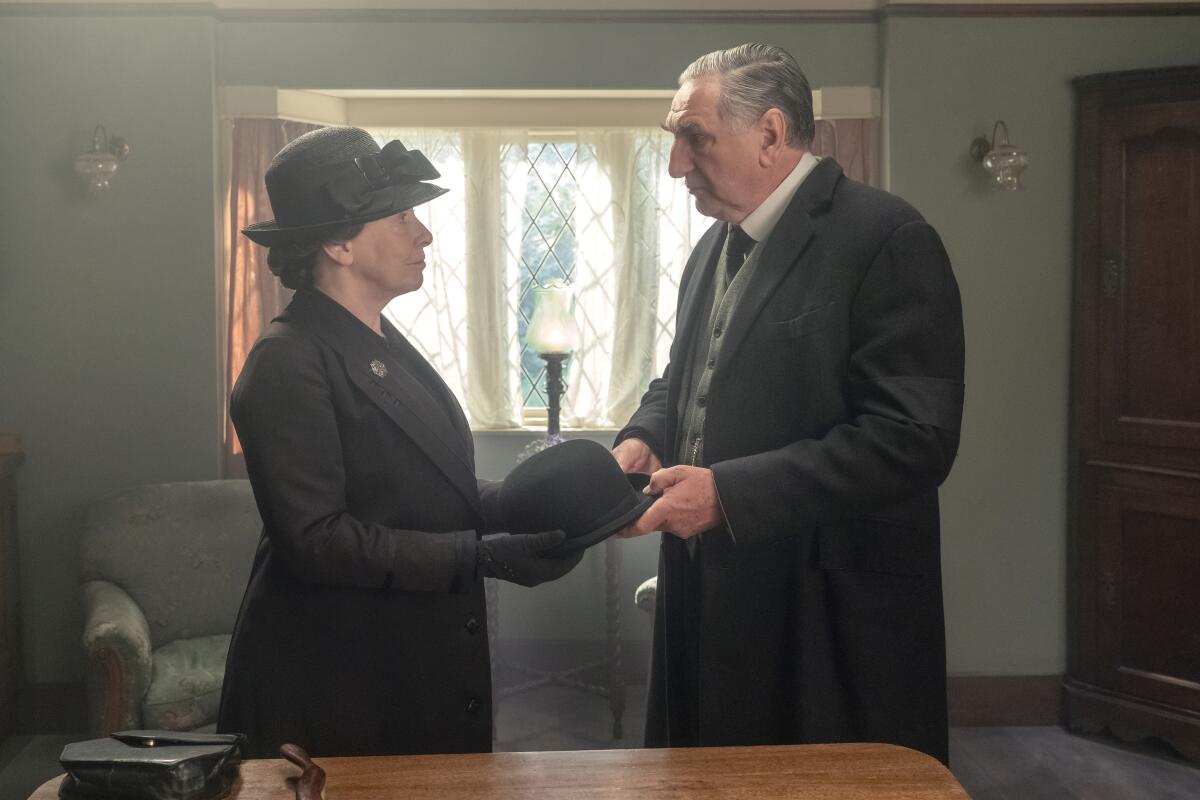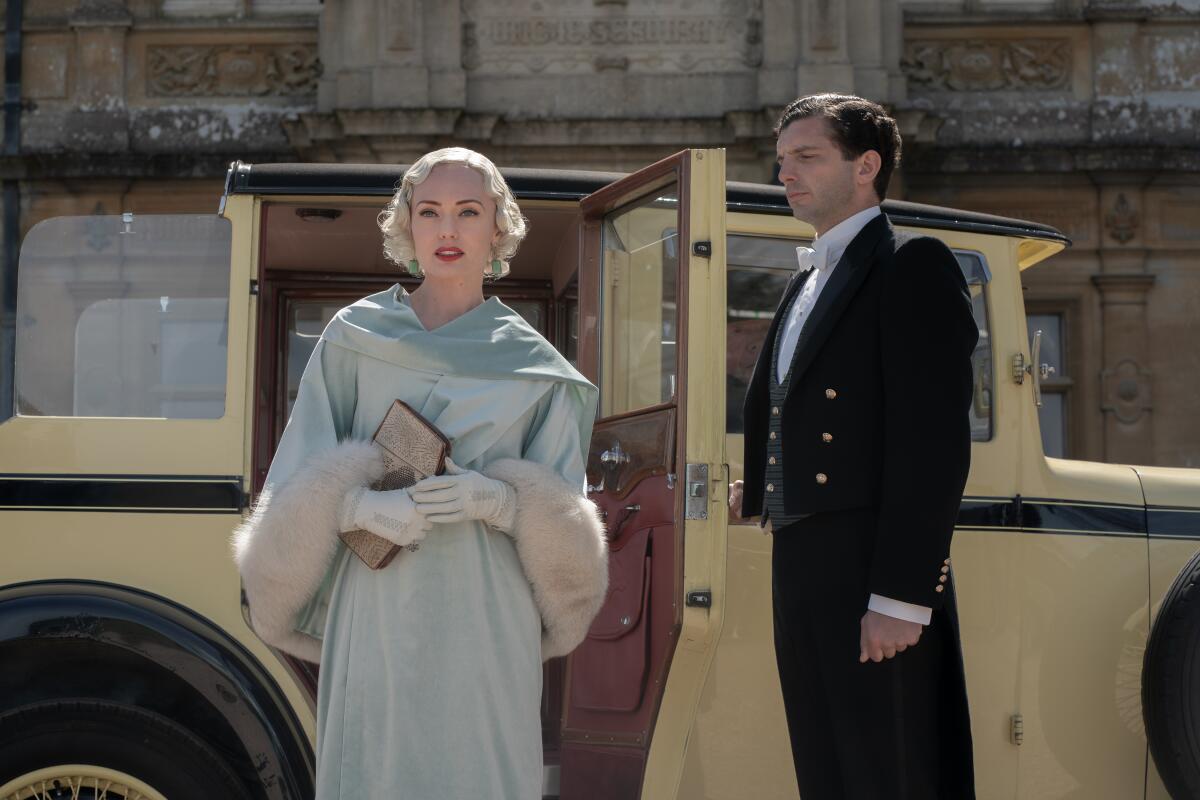Review: Even death can’t spoil the classist cheerfulness of ‘Downton Abbey: A New Era’

- Share via
With the exception of Lady Mary’s conspicuously absent husband, everyone and everything arrives right on schedule in “Downton Abbey: A New Era.” A silent-film director with an eye for manorial splendor turns up with his cast and crew, to the delight of the starstruck servants and anyone who likes a self-satisfied movie-within-a-movie in-joke. A perfectly timed intrigue beckons from the South of France, sending several of the Crawleys off for a few days of sunshine (which almost explains why several of them seem to be sporting poorly applied spray tans). Meanwhile, as those who saw the last movie know, the grim specter of death has also come to Downton, and it too chooses just the right moment, eliciting a few wails and sniffles in between stiff-upper-lip one-liners.
Yes, even the end comes with giggles and reassurances at Downton Abbey, a place so overstuffed with cushions and tapestries that soft landings are all but guaranteed. That was more or less the point of the original Julian Fellowes-created series, which opened on a chaotic moment in 1912, when it appeared that the Crawleys’ gleaming world of aristocratic pleasure and privilege might soon be endangered. Still, in episode after episode, said world managed to prevail over nearly every threat formed against it, whether it came from without (World War I!) or within (scheming servants, first-wave feminist stirrings). Whether you saw this as a loving affirmation of family or proof of a hopelessly classist worldview, the series went down smoothly enough, greased by the droll witticisms of Violet, the Dowager Countess (the great Maggie Smith), and propelled by Fellowes’ skill at distributing his sympathies, at least superficially, between upstairs and downstairs.
For your safety
The Times is committed to reviewing theatrical film releases during the COVID-19 pandemic. Because moviegoing carries risks during this time, we remind readers to follow health and safety guidelines as outlined by the CDC and local health officials.
Fellowes already did that superbly in his Oscar-winning screenplay for Robert Altman’s “Gosford Park,” though that film had the benefit of a sharper class angle and a director skilled enough to hold humanism and cynicism in perfect balance. Next to both “Gosford Park” and the “Downton Abbey” series, the two “Downton” movies feel both graceless and superfluous, partly because they’re structured — seemingly by necessity, though more out of laziness — around some Very Special Surprise Guests who conveniently throw the entire household into disarray. In the 2019 film, the occasion was a royal visit; in the misleadingly titled “Downton Abbey: A New Era,” it’s a film production, led by a producer-director (Hugh Dancy) who wants to shoot on location at Downton. Robert Crawley (Hugh Bonneville), the ever-more-irrelevant lord of the manor, is appalled at the suggestion: Imagine allowing a breed of humanity as vulgar as actors (wink-wink) to besmirch their palace beautiful.
Everyone else thankfully shuts him down, including his steely eldest daughter, Lady Mary (the ever-appealing Michelle Dockery), who notes that the princely sum they’ll get from the shoot could facilitate some badly needed attic repairs. Just as we’re invited to shake our heads in sympathy at the colossal expense and tedium of keeping a house like Downton in working condition, the Crawleys come into unexpected, wholly unnecessary possession of another sprawling piece of real estate. That would be the aforementioned French villa, mysteriously bequeathed by a deceased Monsieur de Montmirail to the Dowager Countess for oh-la-la reasons that will supply the movie’s suspense-free central mystery.

And so Robert and his wife, Lady Cora (Elizabeth McGovern), whose soothing smiles seem a bit more strained than usual, decamp for the Riviera accompanied by their daughter Lady Edith (Laura Carmichael) and son-in-law Tom Branson (Allen Leech), and attended to by Carson (Jim Carter), the staunchly traditionalist butler whose two favorite words are surely “tut” and “tut.” There, as they struggle not to wilt in the Gallic heat, the Crawleys lay claim to their prize and seek out answers from the soon-to-be-evicted Madame de Montmirail (French legend Nathalie Baye, looking suitably frosty) and her more conflicted, hospitable son (Jonathan Zaccaï).
Perhaps a third movie in the “Downton Abbey” franchise, if ever it happens, could savor the delicious spectacle of the Crawleys being unceremoniously kicked out of their own precious country pile. (Or maybe it could be a slasher movie; I’d pay to see “Downton Stabby.”) This one, written by Fellowes and directed by Simon Curtis (“My Week With Marilyn,” “Woman in Gold”) with the same workmanlike efficiency, affords its share of passing pleasures. And not just of the usual luxury-porn variety, although those who watch “Downton Abbey” for the pearls, frocks and waistcoats, the posh furnishings and elegant dinners will hardly be disappointed.

The most diverting subplots arise from the film shoot, specifically its two lead actors, the dashing Guy Dexter (Dominic West) and the sullen Myrna Dalgleish (Laura Haddock), both of whom are guarding secrets behind their glamorous veneers. Both are also troubled by the prospect of their own obsolescence as the silent era gives way to talkies, at which point the movie basically turns into a goofy extended riff on “Singin’ in the Rain,” with Lady Mary playing the mellifluous Kathy Selden to Myrna’s scowling Lina Lamont. (If you didn’t know the art of dialogue looping was discovered at Downton Abbey, now you do.) Inevitably, the shoot becomes an occasion for the servants of Downton to shine, whether it’s the endearing Mr. Molesley (Kevin Doyle) embracing his inner cinema buff; the maids Daisy Parker (Sophie McShera) and Anna Bates (Joanne Froggatt) joining forces to smooth out a kink in the production; or the lonely gay butler, Thomas Barrow (Robert James-Collier), getting an unexpected second chance at love.
A better, gutsier movie might have explored that romantic possibility rather than merely teasing it; it would have also allowed Barrow, one of the series’ most gratifyingly complex characters, to do more than just pine and mope. But then the show, whatever its flaws, had the time and inclination to explore the inner lives of its downstairs characters; the movie, struggling to squeeze a massive ensemble into a two-hour story, renders the help more dramatically subservient than ever. In the most tone-deaf sequence, several of the servants (including Lesley Nicol’s scene-stealing Mrs. Patmore) are invited to serve as extras in a film scene, to don some evening finery and finally sit at the table to which they’ve spent years in dedicated, thankless service. How blessed they are to play aristocrats for an evening! Watch them beam at their good fortune. On second thought, don’t.
‘Downton Abbey: A New Era’
Rating: PG, for some suggestive references, language and thematic elements
Running time: 2 hours, 5 minutes
Playing: Starts May 20 in general release
More to Read
Only good movies
Get the Indie Focus newsletter, Mark Olsen's weekly guide to the world of cinema.
You may occasionally receive promotional content from the Los Angeles Times.











